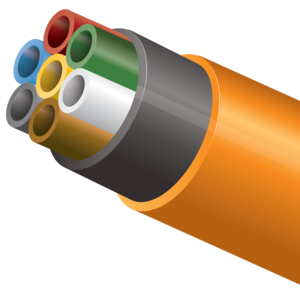5G Behind-The-Scenes
Upgrading millions of interconnected components is a pretty complicated techie task employing an army of self-proclaimed practical, tactical network hardware and software geeks. The journey began with the launch of the first generation, 1G, of mobile technologies in 1983 and hasn’t slowed down since. Fast forward to today, the fourth generation, 4G, is currently in wide use around the world. AT&T, Verizon, and T-Mobile launched 5G in select cities during 2019 and will continue to implement modernizations in 2020. To keep up with demand, the smartest telecommunication engineers are actually juggling sunsetting old technologies, maintaining current communication equipment while managing final build outs of 4G and simultaneously incorporating infrastructure for 5G.

Who’s Investing in 5G?
Construction Build Out
The 5G construction build out is such a massive undertaking that it had been going on in the background for several years before the major telecommunication companies, like AT&T, Verizon, Sprint and T-Mobile, started announcing their progress in 2019. And, there’s still a long way to go in 2020 before 5G will fundamentally change how we live our lives. Experts say to allow a couple of years after full deployment before new disruptive technology will make use of the available high-speed bandwidth capabilities.
The 5G groundwork has been laid…or you might say, the conduit has been deployed. Dura-Line enabled the physical build out of all previous mobile technology generations and has been involved every step of the way with expertise and cutting-edge products designed for a shiny new 5G world. Every time there’s a Dura-Line reel of conduit sitting on the street corner, or orange pathways sticking up out of the right-of-way, there’s an engineer with a multi-layered map designing a faster internet connection. Countless construction crews are slammed with so much work, they can’t hire quickly enough.
In the early years of cable deployment, standard conduit infrastructure was viewed as a rugged, low-cost method of protecting the valuable cable underground. In light of how quickly tech is adapting and the momentum of consumer adoption, now an existing buried conduit pathway is more valuable than the cable inside of it. Rapid, easy cable replacement is a key benefit of a Dura-Line conduit pathway network.
Scalability and maximizing the space in the right-of-way has grown into a more complicated puzzle through multiple evolutions of mobile generations. As the cable sizes have evolved, engineers moved from standard 4” conduit to innerducts and then to MicroDucts (Subdivided Installation, Override Installation) to FuturePath, a bundle of MicroDucts available in multiple configurations coextruded under one protective sheath multiplying fiber count potential.
The amount of bandwidth that consumers are using and demanding is growing so fast that no one knows when it will slow. Dura-Line’s customers are installing as much fiber in conduit as they can to anticipate demand and become future-fit service providers.
Technically Speaking
Surprisingly, wireless relies on wires. Because wireless connections are only wireless over a short range, ultimately 5G depends on fiber in conduit. Just like previous mobile technology generations, small cells also require a power source and backhaul to connect it to the carrier's 5G network, and eventually the internet. And 5G, although it allows a much greater volume of data to be transmitted, has a much shorter wireless transmission range of 100 to 500 meters.
Digital cellular network coverage areas are divided into regions called cells, serviced by towers and individual antennas. 5G uses the combination of new antenna technology (multiple input, multiple output or MIMO) and new frequency bands designated for 5G deployment (millimeter wave frequencies or mmWave) to dynamically send and receive multiple radio beams to and from cell towers simultaneously adjusting the power usage based on the current load (beamforming).
This means to provide complete seamless coverage within a cell, service providers need to lay cable from a central office to hundreds of smaller antennas that can be installed on the side of a building or on top of a streetlight.
The frequency spectrum of 5G is divided into:
- High-band or millimeter waves – enable peak data speeds up to 10 to 20 Gbps with extremely low latency, fastest but shorter coverage area and difficulty traversing walls or obstacles, so more antennas are needed for cell coverage
- Mid-band – fast and offers increased reach, most widely deployed and requires a simple cell tower upgrade for 5G, which will also improve 4G at the edge of the cell coverage area, peak data speeds are 1 Gbps
- Low-band – wide coverage with good building penetration, but peak data speeds are 100 Mbps, similar frequency range and reach to 4G
(Sources: 5G Wiki, 5G Spectrum Bands Allocations)
Telecommunications Infrastructure Investment
Preparing the world for 5G, requires a huge investment: qualified experts, new towers and antennas, network software and hardware upgrades, construction costs, and more. By 2025, the 5G revolution will exceed $326 billion dollars of IT infrastructure spending, according to global technology analyst and advisory firm Moor Insights & Strategy.
Dura-Line supports the 5G wave of digitization with a wide portfolio of high-quality products. As the industry’s only global company, Dura-Line’s geographic footprint with 20 manufacturing plants is a great strategic advantage. Freight costs are lower and delivery times are faster. Millions of meters of conduit have already been delivered. By the time the 5G build out is finished, it will be millions of kilometers.
Transformative 5G
The massive technology transformation of 5G will connect people, things, data, applications, transportation systems, and cities in a new virtual world of smart networked communication environments. Machine-to-machine communication will allow the Internet of Things (IoT), connected vehicles, and exponential industry automation. The capabilities of 5G are mind-blowingly more advanced than just FaceTiming with grandma!
Doctors performing surgeries remotely (telemedicine), hologram calls, driverless cars, ultra-realistic graphics for games, and augmented reality for movies – um, right now please! Sci-fi stories about science and technology of the future are less and less imaginative fiction and more and more promised to be available soon. The paradigm shift that happened because of 4G when half the world’s population immediately embraced smart phones changed consumer’s expectations about the capabilities of technology.
Only fiber optic cables can transport the huge volume of data in a fast, reliable, low-latency manner necessary for the extremely large number of devices about to come online. It’s estimated that more than 50 billion devices will be connected by 2025 to the internet and broadband traffic will increase between 10 to 100 times from 2020 to 2030. (Source)
Avoiding Cyber Traffic Jams
5G infrastructure lays the foundation for the next decade of entrepreneurship, innovation, and automated industrialization. Is your business 5G ready? On the horizon of 2020, faster, smarter, seamless connectivity with artificial intelligence and machine-to-machine communication won’t happen without a fiber network. Dura-Line is transforming the structure of communication by creating what connects us and can help you avoid the approaching cyber traffic jams ahead on an outdated network.







